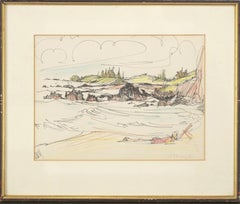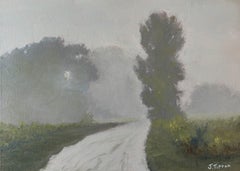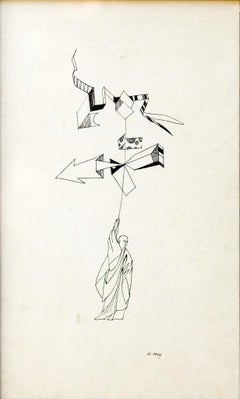Adolf Arthur Dehn
Haitian Scene A, ca. 1951
Watercolor gouache on board
Signed on the front
Frame included: held in vintage modern frame
Measurements:
Framed:
11 inches vertical by 13 inches horizontal by .75
Painting
4.5 inches by 6 inches
Watercolor gouache, hand signed; framed with AAA Gallery label verso
Signed on the front bearing the original label on the verso of Dehn's longtime gallery, the prestigious Associated American Artists Gallery, New York City.
Provenance
Associated American Artists
Frame included: held in vintage frame with original label as provenance
Dehn, an influential artist and teacher (and author of the definitive textbook of his era on watercolor painting) joined Associated American Artists gallery in 1941. Although this painting is undated, it is likely circa early 1950s, as in 1951 Dehn won a Guggenheim Fellowship, which enabled him to travel to Haiti -- the subject of this work. It was part of a series inspired by Dehn's visit to Haiti.
Dehn, an influential artist and teacher (and author of the definitive textbook of his era on watercolor painting) joined Associated American Artists gallery in 1941. Although this painting is undated, it is likely circa early 1950s, as in 1951 Dehn won a Guggenheim Fellowship, which enabled him to travel to Haiti.
ADLOF DEHN
Adolf Dehn, American Watercolorist and Printmaker, 1895-1968
Adolf Dehn was an artist who achieved extraordinary artistic heights, but in a very particular artistic sphere - not so much in oil painting as in watercolor and lithography. Long recognized as a master by serious print collectors, he is gradually gaining recognition as a notable and influential figure in the overall history of American art.
In the 19th century, with the invention of the rotary press, which made possible enormous print runs, and the development of the popular, mass-market magazines, newspaper and magazine illustration developed into an artistic realm of its own, often surprisingly divorced from the world of museums and art exhibitions, and today remains surprisingly overlooked by most art historians. Dehn in many regards was an outgrowth of this world, although in an unusual way, since as a young man he produced most of his illustrative work not for popular magazines, such as The Saturday Evening Post, but rather for radical journals, such as The Masses or The Liberator, or artistic "little magazines" such as The Dial. This background established the foundation of his outlook, and led later to his unique and distinctive contribution to American graphic art.
If there’s a distinctive quality to his work, it was his skill in introducing unusual tonal and textural effects into his work, particularly in printmaking but also in watercolor. Jackson Pollock seems to have been one of many notable artists who were influenced by his techniques.
Early Years, 1895 - 1922
For an artist largely remembered for scenes of Vienna and Paris, Adolf Dehn’s background was a surprising one. Born in Waterville, Minnesota, on November 22, 1895, Dehn was the descendent of farmers who had emigrated from Germany and homesteaded in the region, initially in a one-room log cabin with a dirt floor. Adolf’s father, Arthur Clark Dehn, was a hunter and trapper who took pride that he had no boss but himself, and who had little use for art. Indeed, during Adolf’s boyhood the walls of his bedroom and the space under his bed were filled with the pelts of mink, muskrats and skunks that his father had killed, skinned and stretched on drying boards. It was Adolf’s mother, Emilie Haas Dehn, a faithful member of the German Lutheran Evangelical Church, who encouraged his interest in art, which became apparent early in childhood. Both parents were ardent socialists, and supporters of
Eugene Debs...


